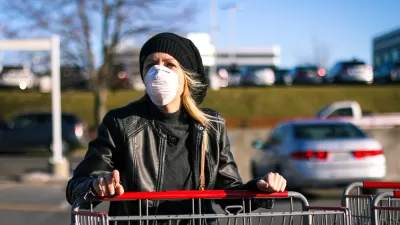While President Trump is publicly stating the virus "will soon disappear," his task force is releasing detailed, county-level data on how all 50 states are dealing with the coronavirus and making recommendations – but the reports are not public.

A 359-page comprehensive report prepared for the White House Coronavirus Task Force details how all 50 states are dealing with the coronavirus and makes recommendations to reduce infections. The July 14 document was obtained by the Center for Public Integrity, a nonprofit newsroom based in Washington, D.C.
"It includes county-level data and reflects the insistence of the Trump administration that states and counties should take the lead in responding to the coronavirus," writes Liz Essley Whyte. "The document has been shared within the federal government but does not appear to be posted publicly."
The report is embedded in Whyte's article, "Exclusive: White House document shows 18 states in coronavirus 'red zone'." Whyte's focus is on those red zone states, "meaning they had more than 100 new cases per 100,000 population last week. Eleven states are in the 'red zone' for test positivity, meaning more than 10 percent of diagnostic test results came back positive."
Just as important as the contents of the report and its recommendation for red zone states, which include reverting "to more stringent protective measures, limiting social gatherings to 10 people or fewer, closing bars and gyms and asking residents to wear masks at all times," is the fact that it is not a public document.
Dr. Ashish Jha, director of the Harvard Global Health Institute, said he thought the information and recommendations were mostly good.
“The fact that it’s not public makes no sense to me,” Jha said Thursday. “Why are we hiding this information from the American people? This should be published and updated every day.”
In fact, the report bears similarity with Harvard's color-coded COVID Risk Level map released July 1 (posted here) that uses almost the same colors to denote the level of risk and is county-specific. Red in the Harvard dashboard means 25 or more new daily cases per 100k people and green less than one case per 100k population. Other than a daily rather than weekly rate, the other difference is that Harvard has a fourth color – orange, while the task force uses only three, with yellow being 10-100 new cases per 100k in the last week.
President Trump and task force send opposite messages
The New York Times also got hold of a task force report and shared it with the public in a way that showed, in its coverage of the White House press briefing on July 28, how President Trump is contradicting the report's findings:
He claimed that “you can look at large portions of our country — it’s corona-free,” even as federal officials distributed a new report finding that 21 states had outbreaks so severe that they were in the “red zone.” Twenty-eight states were in the “yellow zone,” and only one state, Vermont, was in the “green zone.”
And in the section sub-titled, "As Trump called on states to reopen, a federal report urged 21 ‘red zone’ states to impose more restrictions" [source article]:
The report, which was dated July 26, recommended that more restrictions be put in place in “red zone” states. But on Monday, a day later, President Trump called for more states to reopen.
“A lot of the governors should be opening up states that they’re not opening, and we’ll see what happens with them,” Mr. Trump said during a visit to North Carolina — one of the states in the red zone.
As noted in a recent post about the virus moving to rural areas, it's the president's message urging governors to "open-up" that is resonating more strongly with governors like Bill Lee of Tennessee, who rebuffed task force coordinator Deborah Birx's recommendations. "Lee said he would not close bars or limit restaurants or give county mayors the authority to take these actions locally."
Related in Planetizen:
- Pandemic's New Phase: Spreading to Rural and Urban Areas Alike, August 9, 2020
- Do You Know Your COVID-19 Colors? Jul 29, 2020
Hat tip to Ed Pilkington of The Guardian.

Study: Maui’s Plan to Convert Vacation Rentals to Long-Term Housing Could Cause Nearly $1 Billion Economic Loss
The plan would reduce visitor accommodation by 25% resulting in 1,900 jobs lost.

Alabama: Trump Terminates Settlements for Black Communities Harmed By Raw Sewage
Trump deemed the landmark civil rights agreement “illegal DEI and environmental justice policy.”

Why Should We Subsidize Public Transportation?
Many public transit agencies face financial stress due to rising costs, declining fare revenue, and declining subsidies. Transit advocates must provide a strong business case for increasing public transit funding.

Paris Bike Boom Leads to Steep Drop in Air Pollution
The French city’s air quality has improved dramatically in the past 20 years, coinciding with a growth in cycling.

Why Housing Costs More to Build in California Than in Texas
Hard costs like labor and materials combined with ‘soft’ costs such as permitting make building in the San Francisco Bay Area almost three times as costly as in Texas cities.

San Diego County Sees a Rise in Urban Coyotes
San Diego County experiences a rise in urban coyotes, as sightings become prevalent throughout its urban neighbourhoods and surrounding areas.
Urban Design for Planners 1: Software Tools
This six-course series explores essential urban design concepts using open source software and equips planners with the tools they need to participate fully in the urban design process.
Planning for Universal Design
Learn the tools for implementing Universal Design in planning regulations.
Smith Gee Studio
Alamo Area Metropolitan Planning Organization
City of Santa Clarita
Institute for Housing and Urban Development Studies (IHS)
City of Grandview
Harvard GSD Executive Education
Toledo-Lucas County Plan Commissions
Salt Lake City
NYU Wagner Graduate School of Public Service





























